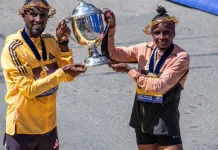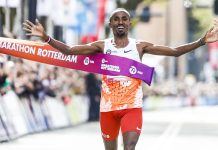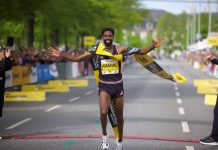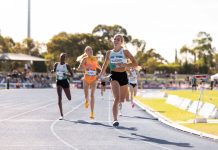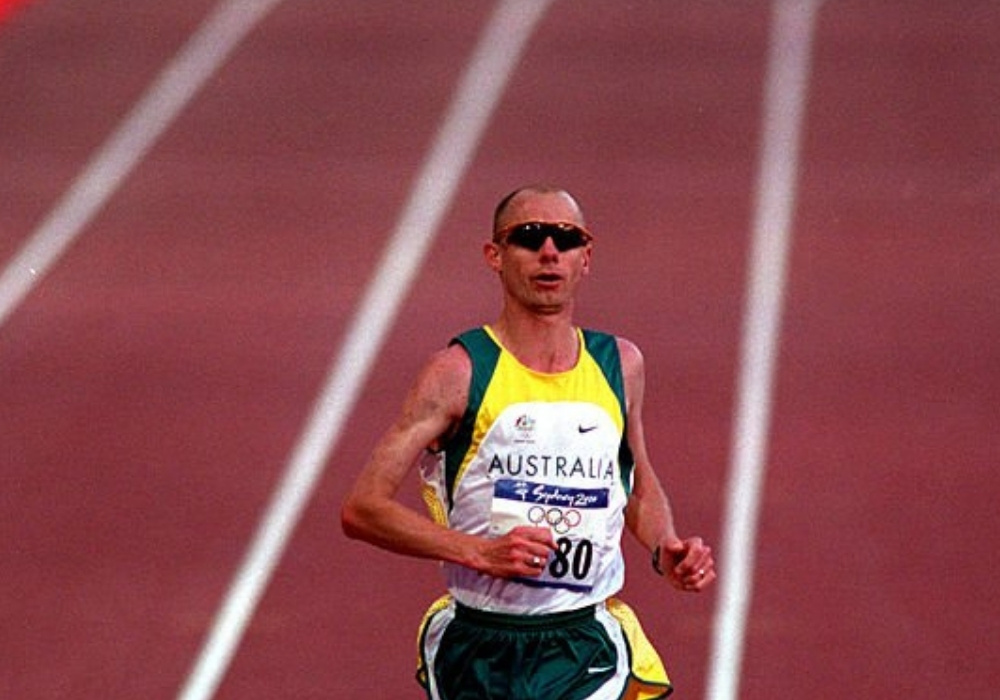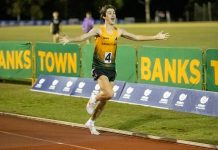
By Brett Davies
With Australian distance running legend Steve Moneghetti celebrating his 60th birthday last week (26/9), Runners Tribe has put together a special three-part retrospective on his best career performances. Parts 1 & 2 looked at his 10 best career performances. In Part 3, we look at his 5 best races on Australian soil plus his life post-career, his contributions away from the track and his incredible legacy. Here are Mona’s top five runs at home:
City to Surf, Sydney, August 1991:
Moneghetti was on another level here. This was his fourth consecutive win in the event, the most wins ever, one ahead of great rival Andrew Lloyd and his fellow New South Welshman, John Farrington.
This was Moneghetti’s final race before the World Championships a few weeks later, where he was a big favourite in the marathon. Moneghetti was in superb form and was targeting the ten-year-old record (40.08) of the great Rob de Castella and he hoped to go under 40 minutes.
Joining Moneghetti and de Castella was one of the deepest fields of Australian distance runners ever assembled. Most of the top runners of the era were there and, for the most part, in good form. Among the elite men, there was Rod Higgins, Jamie Harrison, Lloyd, Pat Carroll, Mal Norwood, Paul Arthur, Dave Evans and Rod de Highden.
Still in his tracksuit, striding out along College Street near the start was an intimidating, powerfully built moustaschioed figure, a 34 year-old sports administrator from Canberra. His name: Rob ‘Deek’ de Castella. De Castella took on the role of Australian Institute of Sport Director the previous year and had had a couple of years of poor form and injury problems but had recently returned to form with a win in the Rotterdam Marathon (2.09.42). Deek would be keen to take on Moneghetti et al and give a good account of himself.
Moneghetti, typically, went out hard from the gun. He blasted down William Street, through the tunnel and, by Rushcutters Bay, he had stretched the field, with only 1990 Commonwealth 5000m champion Andrew Lloyd and Mal Norwood for company. Moneghetti went through 4km in 11.20 (2.50km pace) and maintained the pressure through Rose Bay, with first Lloyd, then Norwood, gradually drifting off the pace.
Moneghetti attacked Heartbreak Hill and built a bigger lead over Norwood. De Castella, meanwhile, was attacking the hill and making ground of 2nd and 3rd, with Carroll trying to go with Deek. Lloyd had passed Norwood and looked strong. Mona was on target, passing 7km (23.21), a few seconds inside Deek’s record pace.
Deek caught Norwood at around 10km and, with Carroll in tow, went straight past the Victorian. Carroll went out in pursuit of Lloyd with Deek struggling, but still moving well. Mona had gone through 10km in 28.58 and extended his lead.
Carroll eventually caught Lloyd with a 1km to go and powered home. Mona went all out along Campbell Parade and as he approached the finish, he began to lift. He sprinted home to finish in 40.03, just outside 40 minutes and 5 seconds inside de Castella’s record. Behind Mona, Carroll finished well, coming home in 40.44 for second, with Lloyd in third 40.50. Deek came home like a train for 4th in 41.00. Paul Arthur was a brilliant 5th (41.31) ahead of Rod Higgins (41.57). Norwood blew up badly and finished 12th. It was by far the deepest field in the event ever, with 3 men breaking 41 minutes, 6 men beating 42 minutes and 15 runners going under 43 minutes.
Mona had run his greatest ever race in this iconic event and set himself up for Tokyo, where, unfortunately, he struggled in the tough conditions and came in 11th. In Sydney, he scored a $50,000 bonus for breaking the record. His record still stands, some 30-odd years later.
NEC Meeting, 5000m.Melbourne, February 1996:
This was one of the great athletics meetings ever held in Australia. Rohan Robinson won brilliantly in the 400m hurdles, Paul Cleary upset the Kenyan legend Moses Kiptanui in the 1500m and Cathy Freeman blitzed the field to run her first sub-50 second 400m. Moneghetti was entered in the 5000m and, after a stint training in Falls Creek, he was keen on a fast time and coach Chris ‘Rab’ Wardlaw suggested that Moneghetti could beat his 6 year-old PB.
The 5000m had a great field. Olympic silver medallist Paul Bitok and Kiptanui were joined by Moneghetti, Julian Paynter, Shaun Creighton, Robbie Johnson, Elijah Miru, Jon Wyatt among others.
Miru, Kiptanui and Bitok went out ridiculously hard, covering the first lap in 59 and the first 1km in 2.34. Kiptanui was in the lead at 2km (5.08) and began to stretch away from Bitok. At this stage, the rest of the field were the length of the straight behind the leaders. Creighton began to push hard at about halfway, separating from the chasing group and gradually gained ground on Bitok. At about 3.5km, Moneghetti had caught and passed his mate Creighton and began to push hard.
Kiptanui, one of the great Kenyan distance runners of the ‘90s, was a world champion steeplechaser and multi world record-breaker. This was a period when Kenyan athletes were coming to Australia over the summer and we were privileged to have one of the greats at one of our premiere track meetings. He had entered the 5000m ostensibly as a pacemaker, though for some reason, he had decided to keep going. He was still well in front at 4km and Mona was, incredibly, making ground on the Kenyans.
With a lap to go, Kiptanui was about 15 metres in front of Bitok and Bitok held the same gap over Moneghetti. As Kiptanui cruised to victory, Moneghetti chased hard and the huge Olympic Park crowd were on their feet. Kiptanui ran what was one of the fastest times in the 5000m in Australia (13.20.51), winning easily. Behind Kiptanui, the battle for 2nd was on. Mona ran hard up the back straight and was almost with Bitok with 150m to go. Down the straight, Mona kicked hard and was almost level with 50m to go. He just went past Bitok with 15 metres left and crossed the line a metre in front of Bitok, ecstatic with his performance and the crowd went berserk.
Moneghetti had run 13.25.77, taking 5 seconds off his PB. He ran a lap of the track and it was incredible to see Mona mobbed in the back straight by fans that poured onto the track. Moneghetti told one interviewer “That’s the first time I’ve ever outkicked a Kenyan!”.
Moneghetti had beaten one of the top distance runners of the era and Bitok would go on to win another Olympic silver in the gripping 5000m final in Atlanta 6 months later. Moneghetti had a huge confidence-builder to go into Atlanta, where he would finish 7th in a hard-fought marathon in tough condition.
Gold Coast Half Marathon. Gold Coast, July, 1993:
Moneghetti was moving towards the World 10,000m Championships and the World Half Marathon Championships in the coming months and this was a big race for him. This was billed as a match race between former world record-holder, Benson Masya from Kenya and the current world record-holder, Moneghetti.
Apart from the two big guns, the race had some solid performers in the field. There was 23 year-old Dave Evans, and seasoned veteran John Andrews. There was also a young Ethiopian named Tadesse Gebre, who was largely unknown.
Moneghetti went out at a solid clip, dragging a pack of about 5 or 6 athletes along at about 2.55 per km. He pressed hard, focused on the road ahead and gradually the pack began to break up and Moneghetti was left with just one athlete for company, Gebre. Masya, carrying an injury, dropped out after just 7km.
In the final few hundred metres, Gebre kicked away and it looked like he was headed for victory. Moneghetti dug deep and chased hard, closing the gap in the last 50m. Moneghetti drew level and the two runners hit the line together. Viewing the footage, the officials were unable to separate the two runners and awarded the win to both Moneghetti and Gebre. Moneghetti thought it was Masya who shared the win. As he’d never met him and was in front the whole race, he’d just assumed it was Masya and was shocked when told it wasn’t. The time was 1.01.48, which would be an all-comers record, until Pat Carroll’s 1.01.11 win in Sydney in May of the following year.
Masya, after a meteoric rise to the top of the sport, faded after a couple of years. He died at just 33 after a period of illness. Moneghetti had a great year in the half marathon, the event that may have been his best. He broke the world record in January in Tokyo, he beat Wayne Larden by almost 2 minutes in the SMH Half Marathon in May and, after the Gold Coast half in July, he narrowly missed gold in the World Championships in October, running a close second to local favourite, Vincent Rousseau.
Zatopek 10,000m. Melbourne, December 1995:
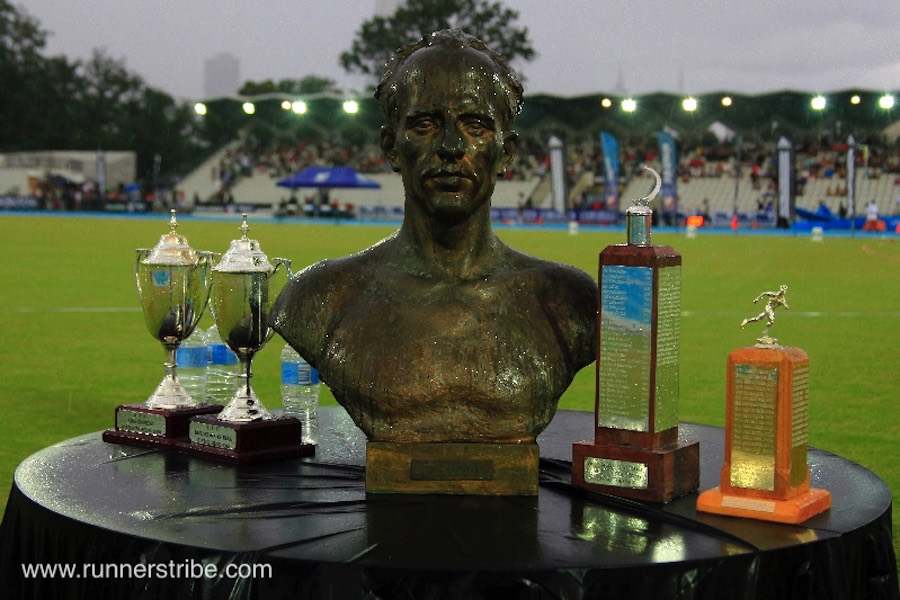
In the 1995 Zatopek, Moneghetti, who was a 4 time winner, would be taking on Kenyan star Joseph Kimani, good mate Shaun Creighton, plus an array of local stars plus Kororia of Kenya and a few Kiwis.
Kimani had been 6th in that year’s World Championships, where Haile Gebrselaisse outkicked both Paul Tergat and Khalid Skah. He was probably on another level to the Aussies, but he would have to work hard.
Creighton was one of the great all-round distance stars of the ‘90s. Initially a steeplechase specialist, he won a World Student Games title and a World Cup bronze, before branching out to the longer races. Over his career, he achieved a range of PBs from a 3.38 1500m to a 2.10 marathon. He has focused on a law career since, but in recent years he has become among the world’s elite Masters marathoners.
Creighton and Moneghetti were training well and looking forward to taking on the Kenyans. The pace was on and the Aussies were right in the mix, taking in up to Kororia and Kimani, with Julian Paynter and Robbie Johnson (NZL) going with the pace too.
They pushed on and with the laps going by in 66-67, we would be looking at one of the fastest 10,000m races ever run in the country.
Creighton and Moneghetti and dropped off Kimani inside the last 600m, but both were in a battle for 2nd. Kimani cruised to victory in 27.38.52 and Creighton outkicked Moneghetti (27.46.87 to 27.48.94). In all, 5 men finished inside 28 minutes, the most ever in a 10,000m race in Australia.
Moneghetti was just over a second outside the PB he ran in Oslo 3 years previously and was very happy with his performance. Creighton would go on to break Ron Clarke’s 32-year-old record the following year and would eventually move to the marathon.
Sadly, Kimani died at just 40 in 2012. It was another tragic early death for a Kenyan star.
Olympic Marathon. Sydney. October 2000:
It was impressive enough from Moneghetti that he was even able to make it to the starting line on North Sydney’s Miller Street, let alone make it into the top ten. The story of how he got there is just as compelling as the race itself.
Moneghetti almost didn’t make it to Sydney. He had suffered a serious achilles problem for 2 years prior to Sydney and had a considerable time away from training in 1999. With missing so much training, he’d run a below par race in the 1999 World Championships marathon and was a distinct possibility of missing the team for Sydney.
A 2.10.00 run in the Tokyo Marathon early in 2000 put paid to any doubts that he was past it. He was added to the team, and he spent the next 8 months preparing in earnest for his first global championship race in front of his home crowd. Moneghetti would retire after this race (or so he said at the time), so he obviously wanted to be at his absolute best.
Great mate and training partner Lee Troop would also be there, and Rod de Highden secured the final Aussie place with a great come-from-behind win over Magnus Michelsson in the Olympic trial in April.
There were several Mona’s rivals from over the years, as well some rising stars in the event. Multiple London Marathon Champion Antonio Pinto (POR) was the favourite, having run 2.06.36 to win London in April. There was also Englishman Jon Brown, who was an accomplished cross-country runner and all-round distance talent. He had publicly denounced Pinto after his 1998 European Championship 10,000m win. Brown had strongly implied that Pinto was a drug cheat and there was a little tension between the two going into the race.
Khalid Khannouchi (USA) was out of the race, but there was reigning World Champion Abel Anton (ESP) and his former world champion compatriot Martin Fiz. The gold and bronze medallists from Atlanta. Josia Thugwane (RSA) Eric Wainaina (KEN) returned and there were two very talented Ethiopians, Fukuoka winner Gezahegne Abera and Tesfaye Tola.
The race began and as the field headed south across the the iconic Sydney Harbour Bridge, winds of up to 65km/hr began to buffer the athletes. Tiyapo Maso of Botswana went out hard and had a substantial lead coming out of Centennial Park and heading south to Kensington. At this point, Lee Troop was up with the lead chasing group and looking good. Moneghetti had decided to hang back in the tough conditions, wary of keeping something in the tank for later.
Abera, who was looking good for most of the way, had a small fall after about 17km, but soon recovered. He joined the pack, and they soon caught the Botswanan. There was a still a decent sized pack that headed back down Oxford St and through the city, at which point, Moneghetti had a bit of a bad patch, but soon recovered and began to catch a few runners. Troop was having a tough day, suffering severe stomach problems.
Brown, Tola, Abera and Wainaina had separated from everyone by 30km, and Pinto and Fiz were more than 30m off the pace.
Abera and Wainaina had dropped Tola at 38km and as they headed down the M4 towards Homebush, Abera accelerated and stole a gap at the 39km point. By 41km (2.06.36), Abera had 30m on the Kenyan and was going away, with Tola a further 70m behind.
Coming into the stadium, Abera had 100m over Wainaina and Tola was a further 200m back. Abera won Ethiopia’s first marathon gold since Mamo Wolde in 1968. He finished in 2.10.11, with Wainaina winning silver in 2.10.31 and Tola the bronze in 2.11.10. Brown had made up a lot of ground to come in fourth in 2.11.17. Moneghetti had come home with a tremendous last 5km. He had run down some big names, such as Thugwane, Natawulikura and finally Pinto inside the last km, finishing 10th in 2.14.50. He had, just like his hero de Castella, finished in the top 10 in an Olympic Marathon on three occasions (7th in 1996 and 5th in 1988). His coach ‘Rab’ Wardlaw later said Mona should have gone out a little harder earlier, as he felt Mona would’ve been closer to the leaders at the finish. Rod de Highden came through in 28th (2.18.04) and Troop, despite tearing stomach muscles, showed amazing courage to finish 66th in 2.29.32.
It was an emotional Moneghetti who spoke to the media post-race. He expressed gratitude for all those who had helped him in his extraordinary career. He had run top 10 in an Olympic marathon after enduring such an arduous build up. He had finished 5th in Seoul and 7th in Atlanta, so his 3 top ten finishes equalled the record of the legendary Rob de Castella.
Post Career Achievements:
Even though Moneghetti had ‘retired’, he has been not that much less active in the sport as he was during his peak. In his 40s, despite running only two thirds of the mileage he would run at his peak, he continued to achieve in the sport. Moneghetti ran 41st in the 2001 World Cross Country Championships and in 2002, he was within a second of Martti Vainio’s world M40 10,000m (28.33.68).
He had been coaching someone during 2003 who was running the national championships in cross country and they talked him into running at the last minute. He won the race and was selected to run for the Australian team at the 2004 World Cross Country Championships in Brussels. At the age of 41, he finished 30th.
He has since run a number of national and international Masters age records. He was able to break 1.10 for the half marathon into his ‘50s and on the weekend, he was 6 seconds from a 60-64yrs record, running 1.14.24 in the Melbourne Marathon Festival. He is a regular at the Lap of the Lake – a record he still holds – and other events held around Lake Wendouree near his home, Victorian Cross Country events and, of course fun runs and mass participation marathons and half marathons all over the country and all over the world.
Sports Admin, Coaching, Public Speaking, Media:
Moneghetti has given back so much to sport, outside of competition. He produced the Moneghetti Report, which was a review into Physical Education and Sport in Victoria. He was chair of the Victorian Institute of Sport and chair of the AIS advisory Board. He is still involved in several activities of the Victorian Department of Education and retains a passion for the development of sporting programs directed at children.
He has continued his involvement with the Australian Commonwealth Games Federation since 2006, when he was Mayor of the Athletes’ Village for the Melbourne Games. He has since been the Chef de Mission for the Australian team for the last 4 Games.
He has been a coach/ mentor for several elite and non-elite athletes over the past 2 decades or so. They all attest to his incredible passion, focus and organizational skills.
The likes of Rod de Highden, Shane Nankervis, Ryan Gregson, fellow Ballarat legend Collis Birmingham, Runners Tribe’s Julian ‘Moose’ Spence, and of course Benita Willis, will all attest to Moneghetti’s incredible achievements, his wise counsel and passionate support as being influential in their success. The late, great Sean ‘Doona’ Quilty and another great athlete we lost way too soon, Kerryn McCann, were very much influenced and inspired in their careers by Moneghetti.
The athlete upon whom Moneghetti had the most influence was, of course his long-time training partner and best mate, Lee Troop. Troop had moved to Ballarat from Geelong in the mid-‘90s, with a view to joining Moneghetti in training sessions. Moneghetti was initially reluctant to have Troop join him, but, despite the two men having different personalities and being separated by a decade in age, they eventually became incredibly close and their different attitudes and approaches to training complemented each other, and Mona became an important mentor to Troop.
Their hard work paid off in spades. Troop broke Ron Clarke’s three decades-old 5000m record in 1999 and he has been an Olympian and World Championships competitor who has distinguished himself with some impressively gutsy performances while wearing the green and gold. He is one of only 6 Australians to have broken 2.10 for the marathon.
Moneghetti has also been a much sought-after public speaker for a number of years and he has become a very skilled, passionate and engaging speaker and Moneghetti is requested for so many speaking engagements that he often will have to turn down offers.
He is also a skilled commentator of athletics events, and he has worked at several major championships since retiring from competition. Notably he has called the City to Surf event on a couple of occasions while actually competing in the race.
Good Fortune Smiles On Mona:
Though he has been lucky in his career, Mona has, for the most part created his own luck. He was lucky though, to enjoy a relatively injury-free career up until his achilles problems in the late-‘90s. this was due at least in part, to his carefully planned training program, his solid biomechanics and the stellar work of Pete Howley, Mona’s brilliant physio – and biographer. His coach Chris ‘Rab’ Wardlaw – a former Olympian – is a master, an absolute guru amongst Australian athletes and Mona developed an especially close relationship with his mentor and he was, of course, instrumental in his extraordinary success.
Moneghetti was also lucky to come along at the right time in history. He was among the first generation of elite athletes for whom becoming full-time professional athletes was a viable career option. The money started to flow in the sport, just as Mona began his rise to world class. He was also competing in a period before marathons were completely dominated by Kenyans, Ethiopians and Ugandans. The East Africans were prominent, though not as completely dominant. The likes of Paul Tergat, Haile Gebrselaisse, Eliud Kipchoge and Kenenisa Bekele et al, changed the face of distance running forever.
It’s fair to say that Steve’s been very lucky with his family. His parents Henry and Wilma were always supportive, as well as his extended family and, of course, his running family. Not only the likes of Rab, Deek, Troopy, Tony Benson, Garry Henry, but so many others have helped Mona over the years and he acknowledges how these people have been crucial to his success. As we’ve discussed though, he has given back in spades.
The most fortunate and important relationship of Moneghetti’s has, of course, been with wife Tanya. They’ve sustained a partnership for over three-and-a-half decades and they’ve brought up 4 kids and enjoyed many highs and some tough times, like the career crisis Moneghetti endured after Barcelona and they have toughed it out through an horrific tragedy, the details of which we need not delve into here. Tanya Moneghetti deserves so much of the credit for Steve’s success.
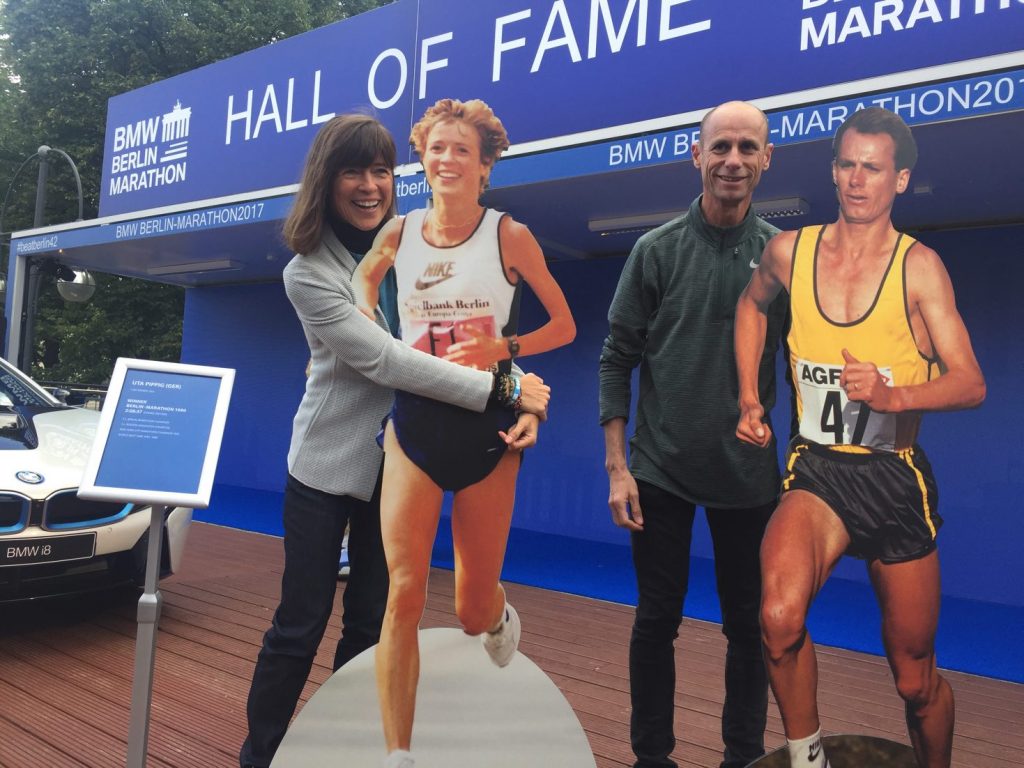
Moneghetti’s Legacy:
Steve Moneghetti will obviously go down in history as one of our all time greats. He has inspired generations of young athletes all over the country and there are so many amateurs out there who have taken up the sport after seeing him win major championship medals and big races all over Australia and around the world.
He has helped make Ballarat a Mecca for Australian distance runners. There was Collis Birmingham’s ‘Ballarat distance Project’, where Mona played a big hand. They were instrumental in bringing many big names to train in the area. The likes of Brett Robinson and Ryan Gregson and others were drawn to Ballarat. With traffic-free back roads, Creswick’s bush tracks and areas like Lake Wendouree, the area is the perfect training environment. It has become like Canberra’s Stromlo Forest or Falls Creek as an iconic Australian training environment.The track around his beloved Lake Wendouree now bears his name, and he still trains there to this day.
His eponymous fartlek session (2 x 90 hard, 2 x 90 second float, 4 x 60s hard, 4x 60 seconds float, 4 x 30 seconds hard, 4 x 30 seconds float 4 x 15 seconds hard, 4 x 15 seconds float) has become a key weekly session for club/university training groups all over the country and all over the world. Moneghetti, as mentioned, is keen to talk to anyone and impart his vast wisdom with anyone keen to have a chat. He is generous to a fault with his time. He remains a key figure in the sport, two decades after his official retirement. For all his success and fame, Mona retains the same outlook on life, despite his education and life experience, he remains the same humble, fundamentally decent ordinary country Victorian bloke he has always been. Happy 60th Mona.
The author wishes to thank:
Len, Ross & Sam @ Runner’s Tribe, Channels 7 & 10 (Australia), Track and Field News, Athletics Today, Athletics Weekly, BBC, ABC, Sydney Morning Herald, The Courier (Ballarat), Bruce McAvaney, Rob de Castella, New York Times, The Guardian.
Editors note: We’d like to thank Brett for this brilliant series highlighting some of the key achievements of one of Australia’s greatest athletes ever.



